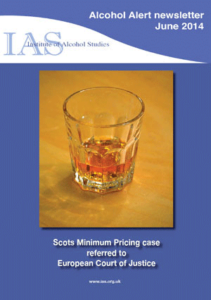In this month’s alert
Editorial – June 2014
Welcome to the first online edition of Alcohol Alert, the Institute of Alcohol Studies newsletter, covering the latest updates on UK alcohol policy matters. In this issue we have an audio podcast of our interview with Eric Carlin, Director of Scottish Health Action on Alcohol Problems (SHAAP), who explains the latest developments in the legal challenge by the Scotch Whisky Association to the Scottish Government on the introduction of minimum unit pricing. There is also news of leaked plans for the Labour Party’s health manifesto, criticism of the latest Public Health Responsibility Deal pledge and updates on alcohol-related violent crime, consumption and mortality figures.
Please click on the article titles to read them. We hope you enjoy this edition.
Scots Minimum Pricing case referred to European Court of Justice
Scottish Court delivers opinion on “precedent-setting” case.
A legal challenge by the Scotch Whisky Association to the Scottish Government’s plan to introduce minimum unit pricing of alcohol (MUP) has been referred to the Court of Justice of the European Union. The development could delay the introduction of MUP in Scotland by a further two years.
The Scotch Whisky Association challenged the legality of MUP under European law. The case was considered by the Scottish Court of Session but it has now decided that it is for the European Union Court of Justice to decide if MUP is legal or not.
 Scottish Health Secretary, Alex Neil, welcomed the referral from the courts and stressed that it was right this “precedent-setting case” was considered by the European Court of Justice, the highest authority on EU law.
Scottish Health Secretary, Alex Neil, welcomed the referral from the courts and stressed that it was right this “precedent-setting case” was considered by the European Court of Justice, the highest authority on EU law.
He said: “The Scottish Government has always believed that minimum unit pricing is the right thing to do and will save lives. Scotland has a difficult relationship with alcohol and we need to urgently take action to tackle this problem that puts a huge burden on our society.
“The evidence shows that minimum unit pricing is an effective way to tackle alcohol-related harm. This is because it targets heavy drinkers, in particular, as they tend to drink the cheap, high strength alcohol that will be most affected by the policy.
“That is why I welcome the referral to the European Court of Justice. Scotland is leading the way in Europe. We are confident of our case and look forward to presenting it in the European Court of Justice. While it is regrettable that this means we will not be able to implement minimum unit pricing sooner, we will continue our on-going and productive dialogue with EU officials.”
Mr Neil added that he was, in fact, travelling to Brussels that very day to discuss the increasing interest among other European Union members, including Ireland and Estonia, in bringing forward a minimum unit pricing policy.
The judgement of the Court of Session was welcomed by the Scotch Whisky Association. David Frost, SWA Chief Executive, said: “We are pleased that the Court of Session in Edinburgh is referring the minimum unit pricing (MUP) case to the Court of Justice of the European Union. From the outset we said that we believed MUP was contrary to European Union law and that it was likely in the end to go to the European Court.
“We also believe MUP would be ineffective in tackling alcohol misuse and would damage the Scotch Whisky industry in the UK and overseas.”
Dr Evelyn Gillan, Chief Executive of Alcohol Focus Scotland and a leading campaigner for MUP said:
“If the appeal judges feel that clarification is needed on technical matters, then we can only hope that this process does not drag on. Every week that minimum pricing is delayed, another twenty Scots lose their lives because of alcohol. It is frustrating to see a policy that has been agreed through the democratic process being held up by big business, who care more about protecting profits than the health and wellbeing of the people of Scotland.”
Dr Peter Rice, Chair of Scottish Health Action on Alcohol Problems (SHAAP) added:
“A minimum unit price of 50p will get rid of the ultra-cheap alcohol which is blighting the lives of too many people, families and communities across Scotland. We have had detailed consideration of this measure over an extended period. Minimum pricing should have been implemented over a year ago and further delay is bad for Scotland’s health and wellbeing. Scotland has led the way in Europe, with interest in minimum unit pricing growing daily. Countries including Wales, Ireland, Poland and Estonia are all keen to see the results of this important measure which we believe will save many lives.”
Follow the link to our Soundcloud page to hear Eric Carlin explain the ins and outs of the legal battle and its wider health and social implications in the first of our Alcohol Alert podcasts: ![]()
Labour to introduce minimum pricing and ban alcohol sports sponsorship?
A leaked draft policy document suggests that a future Labour Government may introduce some tough controls on alcohol, including minimum unit pricing and additional restrictions on alcohol marketing, including a phasing out of alcohol sports sponsorship. A radical proposal also being considered, which has not previously been floated by any political party, is a policy commitment to reduce the level of national alcohol consumption.
The leaked document is Labour’s Policy Review on Public Health, which identifies possible manifesto commitments. The Review identifies alcohol as one of the four main drivers of public health and, therefore, a priority for the next Labour Government. The other drivers are tobacco, food consumption and physical activity.
Alcohol
The policy review says that, after tobacco, alcohol is regarded as the next most important avoidable risk to population health, and it proposes that an ambition be set to reduce the overall population consumption of alcohol in addition to reducing the proportion of the population who consume above the recommended level. The policy options proposed for discussion are:
- A pricing mechanism, such as minimum unit pricing or an alternative, developed both to reduce the availability of high-alcohol, low-price booze which is used for pre-loading, but also to halt the shift in alcohol sales from pubs to major supermarkets.
- The promotion of alcohol through the sponsorship of sport being phased out during the course of the Parliament.
- The positioning of alcohol retail space in supermarkets being regulated – for example, being limited to a single defined area on each premise/physically distant from the front door.
- A review of licensing should be undertaken to:
- Promote a new power to raise a charge to cover the cost of additional staffing required to maintain public order and safety where needed
- Strengthen powers to refuse or withdraw licences to sell alcohol on public health grounds; and
- Enhance the voice of local communities in licensing decisions.
While the proposals contained in the Policy Review are likely to be considered radical, there are some notable omissions and uncertainties. The Review is also vulnerable to accusations of selective memory, given that it, for example, slates the Tory-led Coalition Government for favouring self-regulation and voluntary industry initiatives through the Responsibility Deal without mentioning that the Responsibility Deal began life under the last Labour Government, when it was known as the Coalition for Health.
Similarly, the review criticises the Coalition Government for reneging on the promise to introduce minimum unit pricing, but avoids mentioning that the previous Labour Government rejected minimum pricing as a “tax on the poor” and unfair to responsible drinkers. One major uncertainty in the Review pertains to the possible commitment to reduce the level of population consumption of alcohol. There is no indication of what size of reduction is envisaged, or what level of national consumption a future Labour Government would regard as acceptable.
In regard to pricing, the proposed commitment is to introduce minimum unit pricing “or an alternative”. It is not clear what kind of alternative is being considered, but, perhaps tellingly, there is no suggestion of reintroducing the alcohol duty escalator which the last Labour Government brought in, but which the Coalition Government has abolished. The proposed commitment to introduce minimum unit pricing is presumably dependent on the European Court of Justice deciding that the policy is legal under EU law, but there is no reference to this aspect in the Policy Review.
The discussion of liquor licensing may also be regarded by alcohol control advocates as questionable, given that, with one exception, the policy measures proposed have already been introduced by the Coalition Government. The exception is the implied suggestion of an additional licensing objective to promote and protect public health, but there is no attempt to spell out what this would mean in practice.
Minimum pricing of alcohol also back on the Conservative agenda?
The extensive media coverage of a study of declining levels of violence and the connection with alcohol prices prompted veteran Sky News political correspondent Adam Boulton to predict Prime Minister David Cameron will make a U-turn on his U-turn and revisit his pledge to introduce minimum unit pricing of alcohol (MUP).
Addressing the Spring Conference of the Association of Licensed Multiple Retailers, Boulton – as reported in the trade newspaper Morning Advertiser – said: “If I was thinking of the issues which are likely to return to the agenda, one of those certainly is the question of minimum pricing of alcohol. It seems to me the quite extraordinary media blitz we got last week with the figures on reduction of violent crime and the linking of that to a drop in alcohol consumption means that David Cameron is likely to double back once again – a u-turn on his u-turn – and revisit minimum pricing for alcohol, just as he doubled back on the question of cigarette packaging.”
Newsagents call for MUP
In a move which could be seen as adding weight to Adam Boulton’s suggestion that a political momentum for MUP may develop based on the alcohol-violence link, the National Federation of Retail Newsagents renewed its call for the minimum unit pricing of alcohol, citing the violence study.
NFRN Chief Executive, Paul Baxter, said: “We are pleased to hear that incidents of violent crime have halved in a decade with binge drinking becoming less frequent as consumers are squeezed financially. It has long been our belief that minimum pricing would help cut consumption among those at risk from heavy drinking as well as protecting independent news and convenience store owners who are all too often a target for anti-social behaviour fuelled by people who have got drunk on cheap alcohol.
“In the light of these new statistics, we are renewing calls for the government to think again about minimum pricing. It’s our belief that this will reduce alcohol consumption even further as well as going some way towards helping hard pressed independent retailers compete against multiple chains on pricing.”
Serious violence declines across UK – higher alcohol prices a possible factor
But for how much longer?
Serious violence up to and including homicide is continuing to fall across the UK, with more expensive alcohol and changing drinking habits being suggested as one possible explanation, according to figures compiled by a research group at Cardiff University. However, the Coalition Government’s decision to scrap the alcohol duty escalator and make alcohol more affordable may call a halt to the improvement.
While the UK violent crime rate remains significantly higher than the European Union average, the UK has, nevertheless, become a relatively more peaceful place over recent years. In the UK as a whole, total homicides have fallen by 28% since 2008. In Scotland, the number of homicides has now fallen to its lowest level on record. In England and Wales, the numbers of people injured in serious violence dropped by 12% in 2013 compared to 2012.
Overall, an estimated 234,509 people attended Emergency Departments (EDs), Minor Injury Units (MIUs) and Walk-in Centres in England and Wales for treatment following violence in 2013 – 32,780 fewer than in 2012. The data were gathered from a scientific sample of 117 EDs, MIUs and Walk-in Centres in England and Wales. All are certified members of the National Violence Surveillance Network (NVSN).
The decline in violence according to these A&E data is similar to trends identified in the Crime Survey for England and Wales (CSEW). Overall CSEW violence in England and Wales has been in decline since the mid-1990s and the latest data (year ending March 2013) showed a fall of 6% compared with the previous year.
Lead author of the Cardiff study and Director of the Violence and Society Research Group at Cardiff University, Professor Jonathan Shepherd, said: “The data show another significant year on year fall in serious violence across England and Wales. Apart from a 7% increase in 2008, levels of serious violence have fallen every year since 2001.
“Violence is falling in many Western countries and we don’t know all the reasons why,” said Professor Shepherd. “In England and Wales, the growth of multi-agency violence prevention involving police, the NHS and local authorities may well be a factor; violence has fallen more in regions where this is best organised. Another probable explanation is changes in alcohol habits. Binge drinking has become less frequent, and the proportion of youth who don’t drink alcohol at all has risen sharply. Also, after decades in which alcohol has become more affordable, since 2008 it has become less affordable. For people most prone to involvement in violence, those aged 18–30, falls in disposable income are probably an important factor.
“Continuing, substantial decreases in serious violence are welcome for citizens, communities and in combatting the fear of crime. They also decrease the costs of violence to health services and the criminal justice system and reduce pressures on hard pressed A&Es late at night at the weekend.”
Serious violence affecting all age groups decreased in 2013 compared to 2012, including falls among youth (down 18%); males and females (down 19.1% and 14.1% respectively) and young adults (down 14%; males and females down 14.3% and 13.3% respectively).
The findings confirmed the demographic that those most at risk of serious violence-related injury continue to be males aged 18–30. Violence-related attendance at EDs was most frequent on Saturday and Sunday.
However, if reduced alcohol affordability is indeed a factor in explaining the decline in violence, then it is likely the decline will now begin to go into reverse. In recent years, reduced alcohol affordability has been brought about by the financial recession combined with the policy of increasing alcohol taxes by more than the rate of inflation each year. However, as the economy emerges from recession, and the Government has bowed to pressure from the alcohol industry and scrapped the policy of above-inflation alcohol tax rises, it is presumably to be expected that alcohol consumption will now begin to rise again.
The Government has stated that, as a result of its scrapping of the alcohol duty escalator, it expects alcohol consumption to increase by just under 1% year-on-year until 2018. If the alcohol and violence theory is correct, and there is ample evidence to suggest that it is, then this increase in consumption will be accompanied by a commensurate increase in violence.
Trends in violence-related injury in England and Wales by day (year ending 31 December 2013)

Trends in violence-related injury in England and Wales by month (year ending 31 December 2013)
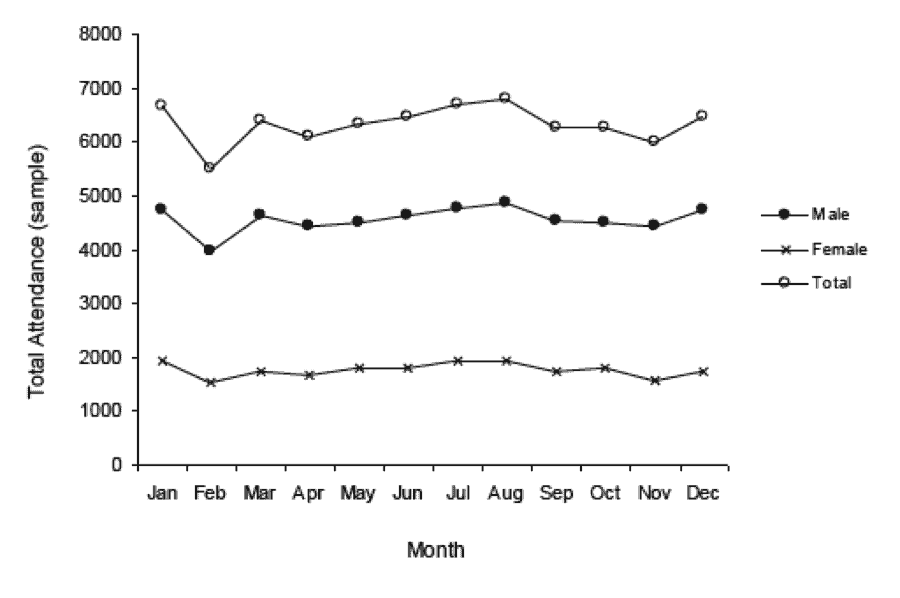
Source: V Sivarajasingam, J P Wells, S Moore, N Page, J P Shepherd, ‘Violence in England and Wales in 2013 – An accident and emergency perspective‘, Violence and Society Research Group, Cardiff University, Heath Park, Cardiff CF14 4XY.
Continued decline in alcohol consumption
But big problems remain
The latest compilation of statistics relating to alcohol show a continued decline in overall national consumption, smaller proportions of people reporting drinking in the previous week, fewer people reporting frequent drinking, and a further increase in school-age children reporting not drinking at all.
However, levels of health harm from alcohol remain at historically high levels and continue to be a drain on NHS resources. In 2013, over £3 million was spent on dispensing drugs to treat alcohol dependence alone, double the cost in 2004.
Statistics on Alcohol – England, 2014, a National Statistics approved publication produced by the Health & Social Care Information Centre (HSCIC), acts as a reference point for health issues relating to alcohol use and misuse, and covers topics such as drinking habits and behaviours among adults (aged 16 and over) and school children (aged 11 to 15), drinking-related ill health and mortality, affordability of alcohol, alcohol-related admissions to hospital, and alcohol-related costs. The report contains previously published information and also includes additional new analyses.
The key findings* for the 2014 edition are:
Drinking behaviour among adults and children
- Between 2005 and 2012 the proportion of men who drank alcohol in the week before being interviewed fell from 72% to 64%, and the proportion of women fell from 57% to 52% in Great Britain.
- Among adults who had drunk alcohol in the last week, 55% of men and 53% of women drank more than the recommended daily amounts, including 31% of men and 24% of women who drank more than twice the recommended amounts in 2012.
- In real terms, between 2009 and 2012, household spending on alcoholic drinks in the UK increased by 1.3%, whilst spending on that bought for consumption outside the home fell by 9.8%.
- In 2012, 42% of school pupils (aged 11 to 15) said that they had drunk alcohol at least once. This continues the downward trend since 2003, when 61% of pupils had drunk alcohol.
Drinking-related costs, ill health and mortality
In 2012-13, there were an estimated 1,008,850 admissions related to alcohol consumption where an alcohol-related disease, injury or condition was the primary reason for hospital admission or a secondary diagnosis. Of the estimated 1,008,850 alcohol-related admissions:
- 65% (651,010) were due to conditions which were categorised as partly attributable chronic conditions.
- 6% (60,830) were for conditions categorised as partly attributable acute conditions.
- Males were more likely to be admitted to hospital with alcohol-related diseases, injuries and conditions than females, with 65% of the overall admissions being male patients.
- However, amongst under-16s, the opposite is true, where females were more likely to be admitted to hospital with alcohol-related diseases, injuries and conditions than males, with females accounting for 55% of all admissions.
- There were 1,890 alcohol-related hospital admissions per 100,000 population in England
- The rate of alcohol-related admissions varied regionally from an estimated 2,500 per 100,000 population in North East Region to 1,500 admissions per 100,000 population in South East Region (all rates, to allow meaningful comparisons, are age and gender standardised).
- In 2012-13, there were an estimated 325,870 admissions where the primary diagnosis or external causes recorded in secondary diagnosis fields were attributable to the consumption of alcohol.
In 2013, 183,810 items were prescribed (in a primary care setting or NHS hospital) for the treatment of alcohol dependency and dispensed in the community. The Net Ingredient Cost (NIC) of these prescription items in 2013 was £3.13 million, which is an increase of £0.2 million since 2012 and just over double the NIC in 2004 of £1.51 million.
In 2012, there were 6,490 alcohol-related deaths. This is a 19% increase from 2001 (5,476) but a 4% decrease from 2011 (6,771).
* Data applies to England only (unless otherwise specified)
Alcohol-related deaths in England continue to fall, but concerns persist about regional inequalities
New figures from Public Health England (PHE) show a continuing benefit from lower levels of national alcohol consumption. However, concerns remain about the impact of alcohol on health inequalities, as deaths in areas of deprivation continue to rise.
The newly updated Local Alcohol Profiles for England (LAPE) indicators, published April 29, show an overall drop in alcohol-related deaths and hospital admissions rates. However, there are wide disparities in alcohol-related health outcomes at a regional level, which raises concerns about the impact alcohol is having on health inequalities. The figures also show that women are not experiencing health gains at the same rate as men.
According to the data, there were 21,485 alcohol related deaths in England in 2012. This represents a 0.4% decrease on 2011, and continues a downward trend in alcohol related mortality in England since 2008. The decrease in the number of alcohol-related deaths between 2011 and 2012 was seen mainly amongst men, as female deaths remained relatively constant over the same period (see Figure 1).
Figure 1: Alcohol-related mortality

Hospital admissions for alcohol-related conditions remain at similar levels with over a million admissions in England between 2012 and 2013 (see Figure 2).
Figure 2: Alcohol-related hospital admissions
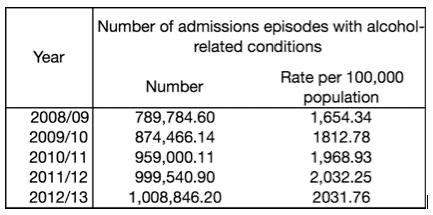
At local authority level, the LAPE data depicts the huge variations between affluent and deprived areas, with some of the most deprived communities seeing an increase in deaths. Of the 326 local authorities included in the data, 145 have seen an increase in alcohol-related deaths among men and 154 among women, compared with the last update in 2012.
When ranked across all alcohol indicators, the areas with the best alcohol health outcomes were situated mainly in England’s southern regions. Figure 3 below shows that four out of the five local authorities with the lowest rates of alcohol-related mortality for men and women were situated in the south of the country, with Suffolk local authorities (Babergh, St Edmundsbury, Suffolk Coastal, Mid Suffolk) having particularly low rates of alcohol related deaths. The local authorities with the highest rates of alcohol-related mortality were situated mainly in the North West, with Liverpool among the worst five areas for both sexes.
Figure 3: Alcohol-related mortality rates by local authority
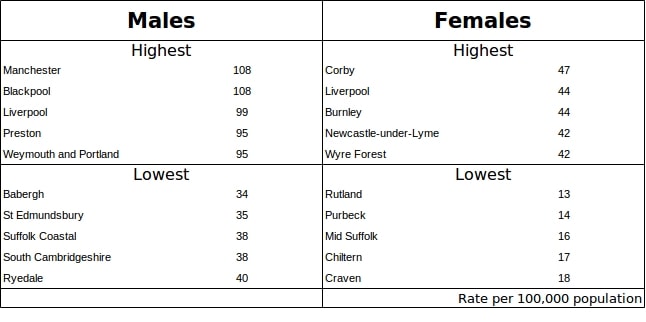
Hospital admissions rates tell a similar story. With the exception of Rushcliffe, the areas with the lowest alcohol-related hospital admissions rates were all situated in the south of England, most notably Wokingham in Berkshire and Chiltern in Buckinghamshire. The regions with the highest alcohol-related hospital admissions rates were concentrated entirely in the North West and North East of the country, notable examples including Liverpool, Manchester and Salford in the North West and Middlesbrough in the North East (see Figure 4).
Figure 4: Alcohol-related hospital admissions rates by local authority

Professor Kevin Fenton, Director of Health and Wellbeing at PHE said:
“We welcome the continuing decline in alcohol related deaths nationally but current levels of harm caused by alcohol remain unacceptably high, especially those in deprived communities, who are not seeing reductions.
“Much of this harm is preventable and we need further action at a national and local level to implement the most effective evidence based policies. Public Health England will continue to provide leadership and support to enable this and reduce the devastating harm that alcohol can cause to individuals, families and communities.”
Visit the LAPE website to download the full dataset.
Plan to reduce premature mortality highlights alcohol
But what has happened to the National Alcohol Strategy?
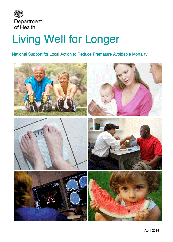 The Coalition Government’s call to action to reduce premature mortality, Living Well for Longer, features action on alcohol alongside other drugs, smoking, obesity, high blood pressure and physical inactivity, but raises as many questions as it answers about how the new approach is meant to tie in with what had previously been launched as the Government’s National Alcohol Strategy.
The Coalition Government’s call to action to reduce premature mortality, Living Well for Longer, features action on alcohol alongside other drugs, smoking, obesity, high blood pressure and physical inactivity, but raises as many questions as it answers about how the new approach is meant to tie in with what had previously been launched as the Government’s National Alcohol Strategy.
Living Well for Longer outlines how national government, the NHS and Public Health England can give combined support to local authorities and their health and voluntary sector partners to prevent avoidable and early deaths ‘on an unprecedented scale’, equivalent to an additional 30,000 lives saved each year by 2020. However, it is entirely unclear whether the single new alcohol initiative proposed in Living Well for Longer is intended to augment or replace the National Alcohol Strategy, to which, strangely, it makes no reference.
Living Well for Longer features alcohol as one of the four biggest behavioural risk factors for illness and death with over 60 diseases or conditions that can be caused by drinking alcohol. Harmful drinking causes cardiovascular disease and increases the risk of various cancers and is a major cause of cirrhosis of the liver. It has been estimated that in 2010 alcohol accounted for over:
- 4,000 deaths from liver disease;
- 7,000 deaths from cancer including 1,200 from breast cancer alone; and
- 300 deaths from cardiac arrhythmias.
Living Well for Longer outlines current ways in which PHE and NHS England are also supporting local authorities and others in tackling the harmful effects of alcohol, through targeted local action:
- From the 1st April 2013, implementation began of an alcohol risk assessment within the NHS Health Check available to all adults between 40 and 74;
- Continued funding a Directed Enhanced Service for GPs to assess and, where appropriate, deliver alcohol brief advice to newly registered patients;
- Expansion of Identification and Brief Advice in a range of settings is underway, particularly in primary care settings, including community pharmacy;
- Offering advice and support to selected areas with significant levels of alcohol-related harm through a network of Local Alcohol Action Areas.
In addition, PHE is supporting local implementation of:
- Alcohol Care Teams in hospital settings coordinating care and services in the community.
- Alcohol service(s) for frequent alcohol-related attenders at hospitals.
- Specialist Alcohol Treatment.
New Initiative
The main new initiative proposed in the document is that Public Health England will produce a report for Government on the public health impacts of alcohol and on possible evidence-based solutions by the end of March 2015. However, it is not made clear why it is considered necessary for Public Health England to compile yet another report on the health impact of alcohol, or what will be added to the existing stock of evidence-based solutions.
Uncertainties are also created by some notable omissions in the document. Public health advocates are likely to be disconcerted by the failure of Living Well for Longer to make any reference to the need for a coherent national strategy to tackle liver disease, given its close connection with alcohol, and given also that liver disease, compared with the other main causes of premature and avoidable death, is the only one showing a steady year-on-year increase. Similarly, while Living Well for Longer cites the Government’s ban on selling alcohol below the price of duty and VAT, it makes no reference to the pledge to introduce minimum unit pricing of alcohol which was previously billed as the main plank of the National Alcohol Strategy, as was referenced by the Secretary of State for Health in the original Living Well for Longer: Call to Action in March 2013. Katherine Brown, Director of IAS said:
“The absence of any reference to the Government’s Alcohol Strategy in the Department of Health’s plans to tackle premature death caused by alcohol gives the impression that we have no joined-up thinking from Government at present on this issue. Such fragmented working implies a lack of strong leadership, and with multiple strategies and frameworks currently in circulation it is not entirely clear who exactly is responsible for reducing alcohol-related deaths and disease rates.
“There is a real opportunity for the Department of Health to take back control of the Alcohol Strategy and act as a vanguard on this crucial public health issue. With death rates from liver disease rising at a time when morbidity from all other chronic conditions is falling, it is vital that we see some coordinated action to reduce harmful consumption of alcohol, based on the evidence of what works.
“We know tackling the affordability of alcohol is the most powerful tool available to reduce morbidity and premature mortality, and the Department should be championing minimum unit pricing – as it was presented in the Government’s Alcohol Strategy – as a policy that will save lives.”
First interim monitoring report on alcohol unit reduction pledge
“One quarter of target achieved” – but IAS challenges the figures
One quarter of the pledge by drinks companies to remove 1 billion units of alcohol from the market by 2015 had been achieved by the end of 2012, it has been claimed.
The pledge, made as part of the Government’s Responsibility Deal on alcohol, is a voluntary agreement with alcohol manufacturers and retailers to remove 1 billion units of alcohol from the market by the end of 2015, using 2011 as the baseline year. The pledge is meant to be achieved by reducing the alcoholic strength of some brands.
However, the Institute of Alcohol Studies (IAS) challenged the accuracy of the figures and also suggested that the implementation of the pledge had been undermined by Chancellor George Osborne’s last budget, which increased the affordability of alcohol. The British Medical Journal also weighed in with an expose of the manoeuvrings behind the report and in relation to the abandoned promise to introduce minimum unit pricing of alcohol.
The Pledge
The interim report of the implementation of the Responsibility Deal, published by the Department of Health, claims that in 2012, 253 million fewer units of alcohol were consumed in the UK attributable to the pledge. Total alcohol consumption, in fact, fell by 1.3 billion units, but most of this decline was due to the decline in the overall level of consumption for reasons unconnected with the pledge. Most of the decline in the number of units consumed attributable to the pledge was due to a reduction in the average strength of beer. There were smaller reductions attributable to reduced strength of ciders and some Ready To Drink (RTD) brands. However, these reductions were offset by increases in the average strength of wine and spirits.
IAS criticism
The IAS challenge to the reliability of the figures was on the basis that the initial calculations appear to have been made by the alcohol industry’s Portman Group, without the then co-chairman of the Responsibility Deal Alcohol Network (RDAN) and Chair of the Monitoring and Evaluation Group (Professor Mark Bellis) being kept in the picture. Indeed, Professor Bellis had resigned his positions at the Responsibility Deal partly in protest at the inappropriate involvement of the Portman Group and the lack of transparency surrounding the billion unit pledge.
Furthermore, the IAS found that, with alcohol affordability increasing after the Chancellor scrapped the alcohol duty escalator in the 2014 Budget, the Treasury predicts that beer consumption will increase by 1.5% and spirits consumption will increase by 1.1% between 2014–2015. This would, therefore, offset any further reductions from the RDAN billion unit pledge.
BMJ on the attack
 In a feature article in the British Medical Journal entitled ‘Alcohol: Is the billion unit pledge just window dressing?‘, freelance journalist Jonathan Gornall questioned whether reducing the strength of alcoholic drinks was a desirable policy in the first place. This was because, paradoxically, instead of reducing the total number of units consumed, the introduction of more low alcohol products could actually increase consumption by their being added to, rather than replacing, the existing number of drinking occasions.
In a feature article in the British Medical Journal entitled ‘Alcohol: Is the billion unit pledge just window dressing?‘, freelance journalist Jonathan Gornall questioned whether reducing the strength of alcoholic drinks was a desirable policy in the first place. This was because, paradoxically, instead of reducing the total number of units consumed, the introduction of more low alcohol products could actually increase consumption by their being added to, rather than replacing, the existing number of drinking occasions.
That, however, is perhaps a strange criticism to be made, given that the public health lobby has been advocating a policy of reducing the strength of alcohol products. For example, the AMPHORA group, an association of leading alcohol researchers and policy advocates at European level, included in their alcohol ‘manifesto’ the demand that alcohol manufacturers reduce the strength of their products just as food manufacturers are reducing the amount of salt in theirs.
However, Gornall suggested that the “most cynical” aspect of the industry’s apparent commitment to the responsibility deal, and the billion unit pledge, “was its determination to use it to intimidate the Government into abandoning minimum pricing.” Gornall quoted a spokesman for the Portman Group as telling the BMJ that minimum pricing was “never part of the responsibility deal or RDAN discussions”. However, Gornall claimed that this statement was, in fact, false, as was demonstrated by a document presented to Health Minister, Norman Lamb, during a Responsibility Deal Alcohol Network meeting at the Department of Health in November 2012.
Gornall argues that the document, a summary of the progress that had been made with another of the Deal’s pledges, an independent alcohol education programme that would rely on industry funding, makes it clear that industry co-operation with the pledges was dependent on the abandonment of minimum unit alcohol pricing. Gornall quotes a section of the document, presented to the meeting by Bruce Ray, Corporate Affairs Director at Carlsberg UK, as stating that companies, including Carlsberg, Diageo, and Heineken, had “indicated their support” for the (educational) programme, but there were “issues which will require resolution before the broader alcohol industry is likely to support this pledge”.
These included “uncertainty over the extent of the Government’s continued commitment to both the Responsibility Deal and partnership working [following] the commitment to introduce minimum pricing in the Government’s alcohol strategy,” which had served “to somewhat undermine the credibility of the Responsibility Deal in the eyes of industry.”
Given these concerns, and “calls for a pause in co-operation from some industry partners,” the document questioned whether there was “sufficient appetite within the wider industry” to support the education and other pledges.
Gornall ends by quoting liver doctor Nick Sheron as saying that throughout its engagement with the Responsibility Deal “the drinks industry have acted purely in their own self-interest, as they always do.”
Sheron added: “It is the job of the industry to make profits, at least 75% of which come from sales of alcohol to hazardous and harmful drinkers, and they have a vested interest in preventing regulation. This was the reason they signed up to the RDAN, and very successful it has been for them.
“The losers in this game are the patients who will die unnecessarily of liver disease. Until we have a government that is more concerned with the health of citizens than the health of the drinks industry, nothing will change.”
Public perceive alcohol adverts breach regulatory code, research finds
A majority of the UK general public perceive TV alcohol adverts to breach the UK Code of Broadcast Advertising (BCAP), new research from The University of Manchester shows, suggesting that the current regulatory system for UK television is inadequate.
Researchers surveyed 373 adults, aged 18-74 years, showing them one of seven adverts that had been broadcast in the previous month on leading commercial television channels. Overall, 75% of the participants rated the adverts as breaching at least one rule from the BCAP Code in all seven adverts.
Rules about alcohol being presented as contributing to popularity or confidence, and implying that alcohol is capable of changing mood, physical condition or as nourishment were seen as being breached by over 50%.
 Professor David French, who led the research, said: “Previous research in the US and Australia has found non-industry experts perceived television adverts to be in breach of their country’s code. We wanted to find out whether this was also the case in the UK.
Professor David French, who led the research, said: “Previous research in the US and Australia has found non-industry experts perceived television adverts to be in breach of their country’s code. We wanted to find out whether this was also the case in the UK.
“Overall we found three in four participants perceived the adverts to breach at least one alcohol-specific rule in the BCAP Code.”
Around £100million is spent on television adverts for alcohol each year, with advertisers arguing these promote brand loyalty but do not influence the amount of alcohol that people drink. But previous studies have found that the greater volume of alcohol advertising that young people are exposed to, the earlier they start drinking and the more frequently and heavily they drink.
Over half of participants perceived breaches of the rules which prohibit advertisements from implying that alcohol can contribute to popularity or confidence or that it was capable or changing mood, physical condition or behaviour.
The Manchester team say the results suggested a need to review the current code.
Professor French added: “Our results suggest that the UK alcohol and advertising industries design advertisements which do not appear to comply with the letter or the spirit of the BCAP code.
“Many adverts allude to themes such as youth culture, immoderation and social and sexual success, although many may not explicitly show them.
“The results of the present analysis, along with the comparatively small number of breaches judged by the Advertising Standards Authority, indicate that co-regulation of UK television alcohol adverts is ineffective and requires further consideration.
“It also suggests that only a minuscule proportion of members of the public who perceive adverts as containing elements that breach the BCAP Code actually report them.”
The study was published in the journal Alcohol and Alcoholism.
TV advertisement warning of alcohol-cancer link vindicated
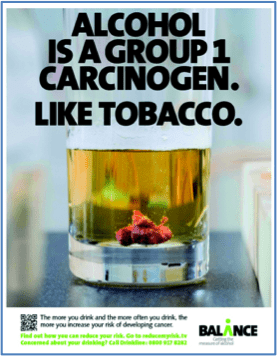
Alcohol industry groups have failed in their attempt to have banned a TV advertising campaign promoting the message that alcohol is a Group 1 carcinogen like tobacco and asbestos.
The Advertising Standards Authority (ASA) has rejected the complaint brought by alcohol industry groups – including the British Beer and Pub Association and the Campaign for Real Ale and the Society of Independent Brewers – against Durham & Darlington NHS Foundation Trust and Balance North East. The complaint was that the Balance NE TV advertisement, designed to increase awareness of the link between alcohol and cancer, was scaremongering, misleading and irresponsible. After reviewing the matter, the ASA concluded that the message of the Balance NE advertisement was properly based on the scientific evidence and was not misleading or irresponsible.
The Advertisement
The TV advertisement featured a man in a kitchen preparing a meal. As he began, he took a beer out of the fridge, poured it into a glass and took a sip. At the bottom of the glass was a small tumour which began to grow as the man took more sips of beer from his glass. As the man took the final sips of beer from the glass, the tumour was seen sliding down the glass towards his mouth. A voice-over stated: “The World Health Organisation classifies alcohol as a Group 1 carcinogen. Like tobacco and asbestos, it can cause cancer. The more you drink and the more often you drink, the more you increase your risk of developing cancer. Find out how you can reduce your risk. Go to reducemyrisk.tv.”
Issue
The complainants claimed that the advertisement was misleading and irresponsible because it gave the impression that drinking a small amount or drinking moderately would increase someone’s risk of developing cancer. In response, Balance said there was a range of peer-reviewed academic papers, available in the public domain, which proved that consuming alcohol increased the risk of developing cancer. In particular, they highlighted a World Health Organisation (WHO) paper, published in 2012, entitled ‘Alcohol in the European Union: Consumption, harm and policy approaches‘, which stated: “In 2007, the International Agency for Research on Cancer concluded that there was a causal link between alcohol and cancer of the oral cavity, pharynx, oesophagus, liver, colon, rectum and female breast. All these cancers showed evidence of a dose response relationship; that is, the risk of cancer increases steadily with greater volumes of drinking”.
In addition, they highlighted a growing body of evidence which suggested that the consumption of any amount of alcohol could increase the risk of cancer. They provided a report entitled ‘Food, Nutrition, Physical Activity, and the Prevention of Cancer: a Global Perspective‘, authored by the World Cancer Research Fund/American Institute for Cancer Research which stated: “The evidence on cancer justifies a recommendation not to drink alcoholic drinks … The evidence does not show a clear level of consumption of alcoholic drinks below which there is no increase in risk of the cancers it causes. This means that, based solely on the evidence of cancer, even small amounts of alcoholic drinks should be avoided”.
Similarly, they highlighted that Cancer Research UK‘s website stated: “The more alcohol someone drinks, the more their cancer risk increases. But even quite small amounts of alcohol, around one drink a day, can increase cancer risk. Expert reports have concluded that there is no lower limit of alcohol drinking where cancer risk isn’t increased”.
Assessment
In its assessment, the ASA stated that it: “considered that the overarching message of the advertisement was that the consumption of alcohol could cause cancer, the more alcohol an individual consumed the greater that risk, and that viewers should reflect on, and potentially reduce, their alcohol intake.
“The ASA did not consider that the advertisement over-emphasised the risk of developing alcohol-related cancers, or suggested that viewers should significantly reduce their intake or abstain from the consumption of alcohol completely.
“In addition, we noted that the advertisement encouraged viewers to visit the website www.reducemyrisk.tv and find out more about the Government’s recommended guidelines and for guidance regarding their own drinking habits. Therefore, we concluded that the ad was not misleading or irresponsible.
“We investigated the ad under BCAP Code rules 1.2 (Responsible advertising) and 3.1 (Misleading advertising), but did not find it in breach.”
“Prisons unable to stem alcohol-fuelled crime”, says leading UK charity
A major survey has revealed that almost all UK prisons are ineffective in dealing with alcohol-related criminal behaviour.
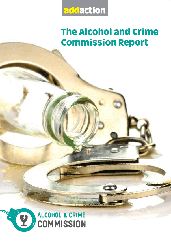 The survey was carried out by a Commission set up by the UK’s addiction charity, Addaction. Consisting of leading figures from across the prison system, Parliament, the treatment sector and the drinks industry itself, Addaction’s Alcohol and Crime Commission report surveyed prisoners across England and found that, while many will be abstinent during their sentence, there is little support to help them understand what part alcohol played in their offending. A lack of support on release means that many return to a life of crime with alcohol again playing a key part.
The survey was carried out by a Commission set up by the UK’s addiction charity, Addaction. Consisting of leading figures from across the prison system, Parliament, the treatment sector and the drinks industry itself, Addaction’s Alcohol and Crime Commission report surveyed prisoners across England and found that, while many will be abstinent during their sentence, there is little support to help them understand what part alcohol played in their offending. A lack of support on release means that many return to a life of crime with alcohol again playing a key part.
“What we have is a booze-fuelled revolving door,” said the Commission’s John Podmore, a professor at the University of Durham and ex-Governor of Belmarsh, Swaleside and Brixton prisons. “And a system that doesn’t understand the complexities of alcohol-related crime.”
Of the prisoners surveyed, 70% admitted they had been drinking when they committed the offence for which they were incarcerated. Yet only half of those prisoners recognised their drinking as a problem. And while 76% were aware of alcohol-related support within the prison itself, only 40% had been informed about support available upon release. It was clear that what was available in prison was based on dependency rather than behaviour and prisoners who had developed unhealthy and dangerous relationships with alcohol were being missed.
Addaction Chief Executive Simon Antrobus commented: “A staggering number of prisoners committed a crime while drinking, but unless they’re alcohol dependent the system doesn’t properly recognise them as problem drinkers. This means that people are leaving prison without the support they need.
“Add to that the fact that after-care is almost non-existent and we end up with a situation where we’re asking people to reintegrate into society, but without any of the right tools they need to do so.”
Following a year’s worth of research and analysis, this commission has made a number of key recommendations that the UK Prison Service should implement “as a matter of urgency”. These include:
- That alcohol treatment services for prisoners should form a key part of any prison rehabilitation, and that this must include continuing support for prisoners as they reintegrate into the community.
- That all frontline staff in UK prisons – from offender managers to peer support workers and mentors – should receive expert alcohol awareness training and be able to identify problematic behaviour relating to someone’s drinking. Without this, the commission says, offenders’ patterns of alcohol-related offending will continue unchecked.
- Support services specifically designed for women prisoners should also be developed as a matter of urgency.
- That the true extent of this problem is properly researched, a thorough and alcohol-specific needs analysis should be carried out into alcohol misuse among the prison population. This needs analysis should then inform the commissioning of services both in prison and on release and be integral to the contracts drawn up for the new Community Rehabilitation Companies (CRCs).
- That all through-the-gate services should prioritise community-based treatment that helps people recover fully in their own communities as well as working to reduce the stigma faced by ex-prisoners and people who have beaten alcohol problems.
The Alcohol and Crime Commission report was presented at the Royal Society for the encouragement of Arts, Manufactures and Commerce (RSA) headquarters in London on 13 May 2014. Audio coverage of the debate around the release ‘Alcohol and Crime: How Do We Break the Cycle?‘ is available to listen to on the RSA website.
Drink banning orders to be tested in London
Drink banning orders, sometimes known as sobriety orders, are to be piloted in four London boroughs for 12 months from June 2014.
 As reported previously in Alcohol Alert (Issue 1 2011), the Alcohol Sobriety Scheme, an initiative of the Mayor of London, is an enforcement approach providing specific powers for the court to ban people, convicted of alcohol-related offences, from drinking. The compulsory no-alcohol requirement will involve monitoring the offender for alcohol, and evidence that he has been drinking will result in immediate breach and sanctions, such as custody.
As reported previously in Alcohol Alert (Issue 1 2011), the Alcohol Sobriety Scheme, an initiative of the Mayor of London, is an enforcement approach providing specific powers for the court to ban people, convicted of alcohol-related offences, from drinking. The compulsory no-alcohol requirement will involve monitoring the offender for alcohol, and evidence that he has been drinking will result in immediate breach and sanctions, such as custody.
A briefing from the Mayor’s Office of Policing and Crime (MOPAC) states the London pilot will be “aimed at a specific cohort of offenders; those convicted of alcohol-related offences stemming from the night-time economy; repeat drink driving offenders; and those convicted of alcohol-related violence offences”. The monitoring will be carried out by means of a ‘transdermal tag’, an ankle bracelet that detects the presence of alcohol secreted in the drinker’s sweat.
The idea of a compulsory Alcohol Sobriety Scheme for London was inspired by a scheme that has been tried and tested in South Dakota and is currently being rolled out in other US states. The Mayor of London tabled an amendment to the Police Reform and Social Responsibility Bill for changes in the current law to enable the courts to make sobriety orders.
In the new pilot schemes, Alcohol Abstinence Monitoring Requirements (AAMRs) will allow courts in four south London boroughs, (Croydon, Sutton, Southwark and Lambeth) to require an offender to abstain from alcohol for a fixed time period, recommended to be between 90–120 days, as part of any community sentence order. The pilot is designed to provide clarity as to:
- How the magistrates will use the sanction and whether or not the sanction proves to be an effective tool for the courts.
- What the expected compliance rate of the AAMR order would be.
- The effectiveness of ‘transdermal tags’ in monitoring alcohol abstinence.
- Programme design – processes and protocols which will lead to the effective use of the Alcohol Abstinence Monitoring Requirement (AAMR).
If the scheme proves to be successful in the pilot boroughs, the plan is for it to be rolled out across London.
Teenagers who participate in sports show lower levels of hazardous drinking
Participation in organised sport can reduce the likelihood of hazardous drinking in teenagers, according to a new study. A feature of particular interest is that the study was of young offenders and teenagers from deprived backgrounds.
The study, published in Criminal Behaviour and Mental Health, aimed to investigate the relationship between participation in organised sports and hazardous drinking, and focused on an under-represented group – young offenders – adolescents who were either excluded from school or involved with the justice system.
93 British male young offenders from a local Youth Offending Team participated in the study, as well as 53 non-offenders from local schools. Both groups had similarly low socioeconomic status. Participants were asked to partake in a Youth Self Report, a questionnaire that measured behavioural problems and competencies as well as recorded levels of involvement in organised sports.
Fewer offenders participated in an organised sport than non-offenders. Approximately 70% of young offenders reported not having participated in any sport or activity. The young offenders group had a significantly higher prevalence of hazardous drinking as compared to non-offenders; this finding contradicts earlier studies that state that participation in team sports indicates an increase in hazardous drinking. The study also highlighted a decrease in drinking for young offenders who participated in a sport. A possible avenue to decrease drinking would be to ensure that youth offenders have better access to organised sports.
“Many young people benefit from participating in fun, structured activities outside of school. However, more vulnerable youngsters, such as young offenders, are less likely to participate even though their engagement in team sports could have positive impacts on their health-related behaviours, including the extent that they misuse alcohol. It is important that the most vulnerable in our community are able to access and enjoy sporting activities,” author Britt Hallingberg, stated.
Five-year alcohol strategy for East Sussex
Raising awareness of the dangers of alcohol and promoting a safer drinking culture are part of a strategy to make East Sussex healthier and safer.
The East Sussex Drug and Alcohol Action Team Board and the East Sussex Safer Communities Partnership have published a five-year strategy to address the issue of alcohol misuse by ensuring authorities share the responsibility and work together. The East Sussex Alcohol Strategy 2014–2019 was drawn up following research into drinking habits, which included a public Drink Debate. It sets out ways in which we can work towards changing the culture around alcohol. The strategy focuses on three priorities:
- Developing knowledge and awareness towards alcohol;
- Providing early help, interventions and support for people affected by harmful drinking; and
- Working with retailers and licensees to promote responsible drinking within the community.
“We estimate that 23% of adult drinkers in East Sussex are drinking at a level that is damaging their health,” said Councillor Chris Dowling, East Sussex County Council’s lead member for Community Services. “This isn’t just about those drinking to excess in our town centres, but also those who regularly drink more than the recommended limits at home.
“Drinking more than the recommended levels can increase the risk of a wide range of health problems such as heart disease, stroke, throat and stomach cancers, liver disease, obesity and dementia. The recommended limit for men is 3 to 4 units a day and for women, 2 to 3 units. A large glass of wine or a pint of strong lager or beer, are each about 3 units.
“Working with our partners, we want to encourage a culture that people who drink do so without harming their health and wellbeing. By offering support and advice to those impacted by alcohol misuse and encouraging communities to have a say in how alcohol impacts on their neighbourhoods we can help to create better and safer socialising environments.”
In drawing up the strategy, the team asked residents what they thought about alcohol and the harm it can cause and analysed local data about alcohol misuse and alcohol-related crime.The aims of the strategy will be achieved through delivery of a co-ordinated action plan. The action plan and the strategy will be monitored throughout the year, and refreshed annually.
Road safety charity calls for zero-tolerance on at-work drink- and drug-drivers
Employers have been urged to implement zero-tolerance policies on staff who drink- or drug-drive on the job.
The call was made jointly by road safety charity Brake and Licence Bureau following a survey that found fewer than half (44%) of employers would dismiss an employee for driving over the legal alcohol limit.
Published in a report for employers with staff who drive for work by Brake’s Fleet Safety Forum, the survey revealed:
- More than half never test employees for alcohol (55%) or drugs (57%).
- Only four in 10 (44%) would dismiss an employee found driving over the legal limit for alcohol.
- Six in 10 (62%) take disciplinary action against employees found to have any amount of alcohol or illegal drugs in their system at work, but only three in 10 (30%) would dismiss employees for this.
- Fewer than half (47%) educate drivers on the risks of drug-driving, and only slightly more (50%) educate drivers on the risks of drink-driving.
Previous Brake research found people who drive for work are especially susceptible to drink driving. They are more likely to admit to driving first thing after having drunk a lot of alcohol the night before, and to driving after taking illegal drugs, than drivers who do not drive for work.
Brake wants any amount of alcohol or illegal drug use at work to be considered gross misconduct. This zero-tolerance policy should be supported by comprehensive alcohol and drugs education, covering such inadvertent risks as ‘morning-after’ drink-driving, and the risks from medicines such as hayfever drugs. Workplace testing for drugs and alcohol would ensure employees are following the rules and help spot any problem drivers before they cause a crash.
Laura Woods, Research and Information Officer at Brake, said: “It is desperately worrying that so many employers are lacking the tough approach needed to tackle drink and drug driving at work. This is highly dangerous, selfish risk-taking that should be treated as gross misconduct. People who drive for work should be clear that there is no safe amount to drink before driving – not a drop. We’re appealing to all employers with staff who drive for work to ensure their drivers know the risks, know the rules, and know that breaking the rules will not be tolerated. Employers can use Brake’s Fleet Safety Forum guidance to review their driving policies and practices, and ensure their drivers are always fit to drive.”
Psychiatrists urge better care for alcohol brain damaged patients
A new report from the Royal College of Psychiatrists calls for clinical commissioning groups to support services that provide specialist care for patients with alcohol-related brain damage (ARBD).
The report highlights how alcohol abuse can cause changes to people’s brain function and intellect, even though many will not be aware of it. However, carers, relatives and others may notice this and it can jeopardise work, family relationships and cause domestic and financial problems.
The report reviews the literature relating to the definition, epidemiology, information on the neurobiological changes associated with ARBD and implications for medical treatments, service organisation and provision, assessment, and psychosocial interventions. An expert panel reviewed the evidence and derived recommendations for commissioners and service providers.
Specific recommendations are presented in the context of four specialist settings: alcohol treatment services, prisons, acute hospitals and pregnancy/foetal alcohol spectrum disorder (FASD).
The report provides examples of service delivery models couched in the context of a team within a mental health trust, accessing clinicians across clinical teams, an ARBD team closely affiliated with the alcohol treatment services and a team embedded within an early onset dementia team. In the absence of significant research (except in a minority of areas), the evidence is derived from descriptive studies and clinical reviews.
This guideline represents the best evidence available and it provides a source document for both commissioners and service providers in the assessment and management of this stigmatised and neglected group of patients.
The report ‘Alcohol and brain damage in adults: with reference to high risk groups‘ was published in association with the Royal College of Physicians (London), the Royal College of General Practitioners and the Association of British Neurologists.
Government and National Union of Students work to reduce binge drinking at universities
What is described as a radical new project designed to tackle the culture of binge drinking at universities across England and Wales has been launched by the Government and the National Union of Students.
Seven universities have signed up to a 12-month pilot scheme to encourage responsible drinking among students.
Loughborough, Nottingham, Manchester Met, Liverpool John Moores, Swansea, Brighton and Royal Holloway universities are hoping to gain accreditation under the NUS Alcohol Impact Scheme for their work in promoting responsible alcohol policy and practice. They will aim to reduce alcohol-fuelled crime and disorder and prevent health harms.
Accreditation will be awarded to universities which meet a set of criteria committing them to actions such as preventing alcohol-related initiation ceremonies, tackling student participation in pub crawls and monitoring antisocial behaviour.
Responsible drinking communications campaigns, formal training for university staff on alcohol harms and developing social alternatives to licensed premises are also among the criteria which the universities will work towards.
Alcohol-fuelled crime and disorder
Crime Prevention Minister, Norman Baker, said: “Binge drinking at universities is nothing new, but that doesn’t mean it is a good idea. The NUS Alcohol Impact project, backed by the Home Office, will help participating universities to encourage responsible drinking, leading to safer and more productive places to study and live.
“Accreditation should become a badge of honour for universities, and another factor which helps promote their world-class teaching and research to prospective domestic and international students.”
NUS Vice-President (Welfare), Colum McGuire, said: “We hope that the work of the project will allow us to create a social norm of responsible consumption by students at the pilot institutions, changing attitudes and behaviours towards alcohol, leading to safer and more productive places to study and live.
“Students, academic and support staff, students’ unions, police and residents’ groups will all be involved in working to meet the accreditation.
“The NUS will monitor the success of the scheme through detailed surveys comparing student experiences of crime and disorder, as well as tracking crime rates, during the period of the pilot.”
The launch of the campaign did not, however, meet with universal approval. The Guardian newspaper published a comment piece ‘Don’t lecture students about alcohol when austerity will hurt them most‘. The comment, written by PhD student Nat Rutherford, condemned the campaign as moralistic and argued that students might be forgiven for resorting to blackout-inducing levels of drinking when they were amassing an average £40,000 worth of debt. Mr Rutherford explained that binge-drinking had played an important role in his life at university. His closest friendships were forged through the shared pain of hung-over mornings, and he doubted that he could have made such attachments “without the inhibition-shattering, confidence-boosting power of alcohol”.
Former Labour Party spin-doctor, Alistair Campbell, was equally critical but from the opposite standpoint. Speaking to the Independent newspaper, Mr Campbell said the campaign did not go far enough.
He said: “It [the campaign] doesn’t appear to challenge the industry and what they do to target students on arrival at university and puts it all on the universities and the students. So much of this is about marketing and communications, which have created a culture in which excessive consumption is totally normalised.
“The Government cannot continue to avoid challenging the industry, having caved in over minimum pricing, caved in in the recent budget and caved in over the World Cup, yet again buying into the industry message that people cannot enjoy sport without alcohol.”
Young people pre-load at home because of “scary” bars and nightclubs, study suggests
Young people’s increasing tendency to ‘pre-load’ before a night out is due to their not liking the traditional pub environment, but also that they need alcohol to cope with the often “scary” atmosphere of bars and nightclubs, according to a study by Plymouth University.
The differing price of alcohol in shops and licensed premises was also reported as a major factor in the study, which set out to explain the growth of pre-loading, signalling a move from a pub-club to a home-pub-club culture.
Dr Adrian Barton, Associate Head of Plymouth University’s School of Government, led the study, published in the scientific journal Drugs and Alcohol Today.
He said: “In our minds, pre-loading is fast becoming a significant cultural shift in the consumption of alcohol in the UK. But policy makers’ understanding of the practice is limited, meaning that alcohol policies locally and nationally are failing to reflect its significance. This is predominantly down to an over-reliance on the assumption it is linked to economics, and until policy makers and those leading the NTE [night time economy] industry recognise it as a significant cultural shift, alcohol policy will continue to fail to reach as much as 80% of some people’s alcohol intake.”
Previous studies conducted by Dr Barton and Dr Kerryn Husk, from the University of Exeter Medical School, have shown that 60–70% of people drink some alcohol prior to going out, with around 50% of people consuming significant quantities. They have also demonstrated that pre-loading is a culturally embedded practice planned and based on a desire to achieve intoxication prior to entering the NTE.
The new research was carried out over a three-month period, with young people aged 18 to 23 interviewed at length about their drinking habits. They were asked to recount their pre-loading experiences based around frequency, planning, rituals and its relation to going out.
Their answers showed more planning was often put into the pre-loading than the rest of the night out, but also revealed some insights into young people’s perceptions of the NTE. Among the responses to questions about why young people pre-load were:
“I get scared in clubs so drinking before I go out gives me the courage to face it”, and
“… what I like is the feeling of being with my mates but feeling safe. I don’t get that in the pub but I do get it at home”.
Dr Barton added: “Beyond price, young people seemingly need alcohol to cope when going out and many of the young respondents prefer the comfort and safety drinking with people known to them brings. Equally, those charged with designing pubs and clubs are seemingly failing to understand or accommodate the needs of young drinkers. Those working within the NTE and alcohol policy communities need to be aware that despite some good improvements in safety and environment, the NTE still remains a place where some young people feel afraid.”
Podcast
Our monthly podcast features interviews with experts from across the sector.
Gambling industry harms and parallels with the alcohol world
Will Prochaska –
Coalition to End Gambling Ads

